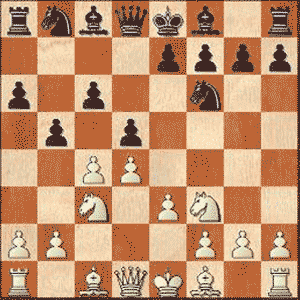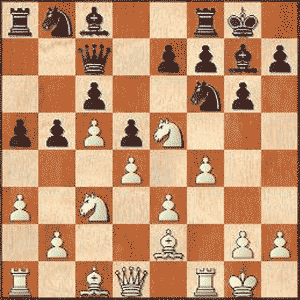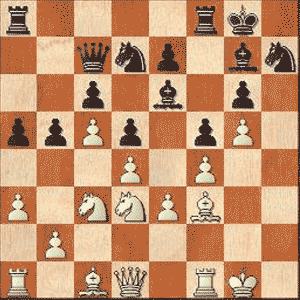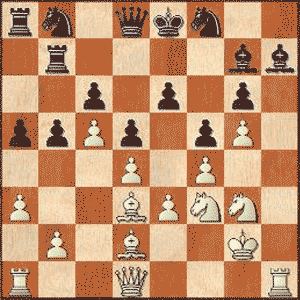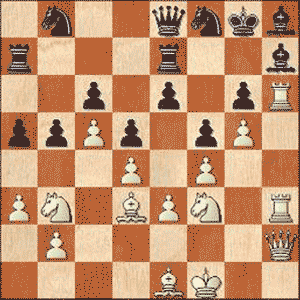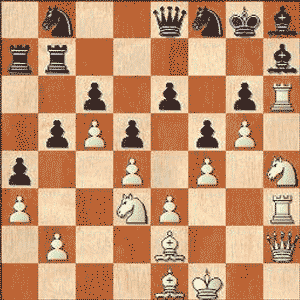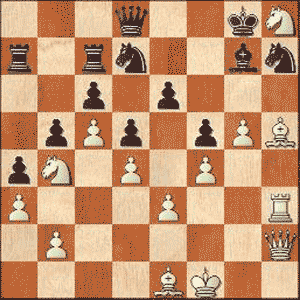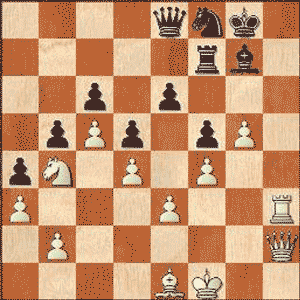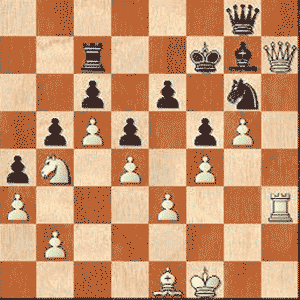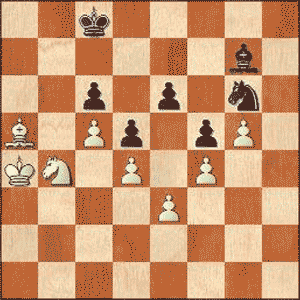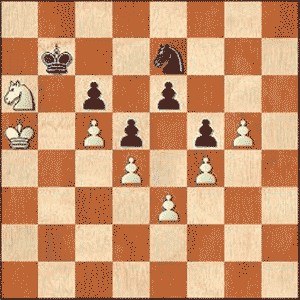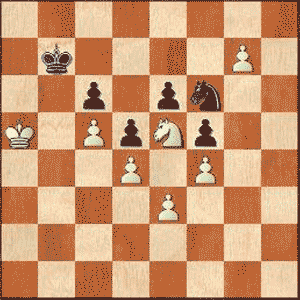| Back to Back Issues Page |
 |
|
LCB, Issue #086 --, Step Through a Game of a Grand Master August 01, 2022 |
Step Through a Game of a Grand MasterLapoc Chess Board, Issue #086 -- GOTM #56 learn and play online chess How does a Grandmaster approach a serious game against a rival? What goes through his mind as he plays the game? What does he consider as he chooses his moves? Most GMs have an extensive opening repertoire. They would know the main ideas from all main openings. They would also have a deep intricate knowledge of the openings they like to play. Their analysis of middlegame positions is very good because they are well versed in all aspects of what Nimzowitsch used to call the elements. They also familiar with thematic ideas and how to handle the pieces to get the most out of them. The great GMs play an amazing endgame. Let's step through a GM encounter as described by one of the protagonists. The game was played in Bazna, Romania in 2010. Boris Gelfand of Israel had White and Wang Yue of China had Black. Step Through a Game of a Grand MasterGelfand, Boris - Wang, Yue [D15]GotM #56 - Bazna, 2010 [Gelfand, Boris] 1.d4 d5 2.c4 c6 3.Nc3 Nf6 4.e3 a6 (This was my 3rd meeting with Wang Yue in recent months. In the first 2 games he tried 4...g6, but both times I got an advantage from the opening. So it came as no surprise that he decided to play another line.) 5.Nf3 b5
6.c5 (I met the Chebanenko system for the first time back in 1990. I'll include that game in these annotations, as it shows similiar ideas to ones in this game. 6.b3 g6 (6...Bg4) 7.Be2 Bg7 8.0-0 0-0 9.Ne5 Bb7 10.f4 Qd6 11.Bf3 Nbd7 12.Qe2 Rab8 13.g4 Rfd8 14.g5 Ne8 15.Qg2 bxc4 16.bxc4 e6 17.Rb1 Ba8 18.c5 Qe7 19.Bd2 Rxb1 20.Rxb1 Rb8 21.Rxb8 Nxb8 22.Na4 Bb7 23.Ba5 Bxe5 24.dxe5 Nc7 25.Nb2 Nb5 26.a4 Qxc5 (26...Na3 27.Bb4 Nc4 28.Nxc4 dxc4+-) 27.axb5 Qxe3+ 28.Qf2 Qxf4 29.Bd2 Qxe5 30.Nd3 Qf5 31.Qa7 Nd7 32.Ne1 Bc8 33.Qc7 1-0 Gelfand, B (2680) - Hort, V (2545)/Novi Sad (1990)) 6...g6 7.Ne5 (7.Be2 Bg7 8.Ne5 0-0 9.0-0 Be6 10.f4 Qc7 11.g4?! Ne4 12.Bf3 f5 13.Bd2 Nd7 14.Be1 Nxe5 15.fxe5 Nxc3 16.Bxc3 Bh6 0-1 Gelfand, B (2717) - Bareev,E (2675)/Khanty Mansyisk, RUS 2005) 7...Bg7 8.f4 a5 This plan was tried twice by my opponent vs E. Bacrot and both times he had no problems from the opening. 9.Be2 (9.Bd3 Bf5 10.Bxf5 gxf5 11.Bd2 e6 12.Qe2 h5 13.0-0-0 b4 14.Na4 Ne4 15.Nb6 Ra7 16.Nd3 Nd7 17.Nxd7 Kxd7 18.Rdg1 Qb8 ½-½ Bacrot,E (2705)-Wang Yue (2736)/Elista RUS 2008) 9...Qc7 10.0-0 0-0 11.a3!
This is a new and important idea. I was waiting for a chance to use it for a couple of years. We had analysed my game vs Bareev with Alexander Khuzman and had realized that e4 is the key square in such a position. (11.Bd3 Bf5 12.Bxf5 gxf5 13.Bd2 Nbd7 14.Be1 e6 15.Rf3 Ne4 16.Nxe4 dxe4 17.Rh3 Rfe8 18.Nxd7 Qxd7 19.Qh5 h6 20.Bh4 Ra7 21.Rg3 Kh7 22.Bg5 Rh8 23.Qh4 Qe8 24.Bf6 Bxf6 25.Qxf6 Rg8 26.Rxg8 Qxg8 27.Kf2 Rd7 28.Rg1 Qd8 29.Qxd8 Rxd8 30.g4 fxg4 31.Rxg4 f5 ½-½ Bacrot, E (2705) - Wang Yue (2736)/Dresden GER 2008) 11...Be6 (If 11...Ne4 then 12.Nxe4 dxe4 13.a4 b4 14.Qc2 keeping an advantage.) 12.Bf3 Taking control of the e4-square. 12...Nbd7 13.Nd3! Of course, White is avoiding any exchanges as Black's pieces are very cramped and he does not have
enough space for them. 13...h6?! Faced with a new plan my opponent thought for a long time and decided to build a wall. (I would rather go for 13...Bf5 trying to exchange the poor Bishop) 14.g4! It was easy to let slip the advantage: (After 14.Bd2 Bf5 15.Nf2 g5 Black has nothing to worry about.) 14...Nh7 (14...h5 15.h3 hxg4 16.hxg4 g5 17.Kg2 just plays into White's hands.) 15.h4 f5 16.g5 hxg5 (During the game I thought that 16...h5 would be even worse as h5 becomes a target and White would sacrifice a Knight on h5 in good circumstances, for example 17.Ne2 Bf7 18.Ng3 e6 19.Bd2 Rfb8 20.Nxh5 gxh5 21.Bxh5 However, now things do not seem so clear to me, as Black would sac a piece, let's say, by 21...Bxh5 22.Qxh5 Ndf6 23.gxf6 Nxf6 with good defending chances.) 17.hxg5
So, White has won some more space. The pawns on c5 and g5 are limiting Black's pieces to the last 2 ranks. The next step in White's plan is to regroup his pieces. Black has no counterplay whatsoever and has to wait. 17...Kf7 18.Kg2 Rfb8 19.Bd2 Nhf8 20.Be2 The Bishop is going to d3 and the Knights to f3 and g3. 20...Ke8 21.Ne1 Bg8 22.Nf3 Rb7 23.Bd3 Nb8 24.Ne2 Qd8 25.Ng3 White is threatening a sacrifice on f5 and Black is obliged to play e6. 25...e6 26.Rh1 Bh7?
Black wanted to hide his King on g8, but it allows White a strong regrouping. I still
believe that waiting passively was the best option. (Here I was looking for a plan how to break through, if Black simply waits. It seems possible, that the piece sac e3-e4 would work, for example 26...Nbd7 27.Qe2 Nb8 28.Rae1 Nbd7 (probably better is 28...Re7However it is difficult for Black to defend against all the ideas - White wants to play Bc3, Qd2, Ne2-c1-b3, forcing a4, then he can play e3-e4 in good circumstances: then he can bring the Knight to e5 through d3 etc. 29.Bc3 Qc7 30.Qd2 Nbd7)29.e4 fxe4 30.Bxe4 dxe4 31.Nxe4 with the idea of Nd6,Ne5. Another plan would be to move the Knight to d3, Qe1, plan a4 and sac a N on b4 after b5-b4, followed by the advance of the b-pawn. However, it is very hard to say, if White's advantage is enough for victory.) 27.Qc2 Kf7 28.Rh3 There is no need even to consider an e3-e4 breakthrough, as White has a better plan at his disposal. 28...Kg8 29.Rah1 Now the Bishop cannot return to g8. 29...Raa7 30.Kf1 Qe8 31.Be1 Bh8 32.Rh6 Bg7 33.R6h4 Bh8 34.R1h3 White is tripling his major pieces on the h-file according to Alekhine's advice - first the pair of Rooks and the Queen behind them. 34...Re7 35.Qh2 Reb7 36.Rh6 Re7 37.Ne2 Reb7 38.Nc1 Re7 39.Nb3
It is important to force Black to play a4, as it gives White the b4-square and the possibility to open the position by b3, if nessesary. Even though the main action would most likely take place on the Kingside, you should never neglect such a detail. 39...a4 (Or 39...Qd8 40.Qd2! a4 41.Nc1+-) 40.Nc1 Reb7 41.Be2 Re7 42.Nd3 Reb7 43.Nh4!
White has placed his pieces ideally - it is time to go for an attack! 43...Bg7 (43...Re7 44.Nxg6 Nxg6 45.Bh5 Bg7 (45...Rg7 46.Ne5)46.Bxg6 Bxg6 47.Rh8++-; 43...Nbd7 44.Nxg6+-) 44.Rxh7! Nxh7 (44...Kxh7? 45.Nxg6+ 45...Kg8 46.Rh8+ Kf7 47.Nde5+ Bxe5 48.Nxe5+) 45.Nxg6 Nd7! the only defence (45...Qxg6? 46.Bh5+-; 45...Bxd4 46.exd4 Qxg6 47.Ne5;) 46.Bh5 Qd8 (46...Ndf8 47.Nxf8 Qxf8 48.Bf3 winning the Knight.) 47.Nb4 Rc7 (47...Nb8 48.Ne5 Bxe5 49.dxe5 Rg7 50.g6 Nf8 51.Bh4 Qe8 52.Bf6 with an easy win.) 48.Nh8!!
A beautiful way to launch the final attack. I got really excited when I saw this possibility. Strangely enough no engine on my computer indicates it even set to a depth around 20 moves. (I was also thinking about 48.Ne5, but I was not sure how to progress after 48...Nxe5 49.dxe5 Nf8 50.Nc2 Nd7 51.Bb4 Qe7 52.Nd4) 48...Ndf8 (I believe that the most stubborn was 48...Kxh8 49.Bf7 (49.Bg6 Ndf8)49...Ndf8 50.Rxh7+! Nxh7 51.g6 Bh6! The only defence 52.Qxh6 Rxf7 53.gxf7 Rxf7 54.Nxc6 and despite being an exchange down, White is going to win - for example 54...Qe8 55.Ne5 Ra7 (55...Rf6 56.Qh4+-) 56.Bb4 Rc7 57.Ke2 Rc8 58.Kd2 Rc7 59.c6 Rxc6 60.Nxc6 Qxc6 61.Qg6+-; 48...Bxh8 allows the nice 49.Bf7+!! Kxf7 50.Rxh7+ Bg7 51.g6+! Kf8 (51...Kg8 52.Rh8+; 51...Ke8 52.Rxg7 Nf8 53.Rg8 Rg7 54.Rxf8+ Kxf8 55.Nxc6) 52.Rxg7+-) 49.Nf7 Rxf7 50.Bxf7+ (White had another way to victory 50.Nxc6 Qa8 51.g6 Nxg6 52.Bxg6 Qxc6 53.Bxf7+ Rxf7 54.Rxh7+-) 50...Rxf7 (50...Kxf7 51.Nxc6+-) 51.Rxh7 Qe8 (Or 51...Nxh7 52.g6! Rc7 53.Qxh7+ Kf8 54.Bh4! Qe8 55.Bg5 winning easily, for example 55...Qd7 56.Bh6 Bxh6 57.Qh8+ Ke7 58.Qxh6 Qe8 59.Qh7+ Kd8 60.g7+-) 52.Rh3
Already here I saw it till the end. White exchanges Queens, plays b3, then a4, exchanges Rooks on a line and penetrates by Bishop and Knight into the enemy's camp. 52...Ng6 53.Qe2 Rc7 54.Qh5 Kf7 55.Qh7 Black cannot avoid the exchange of Queens. 55...Qg8
(55...Nf8 56.g6+ Nxg6 57.Rg3; 55...Qd8 56.Rh6 Nf8 57.Nxc6 Rxc6 58.g6+) 56.Qxg8+ Kxg8 57.Nd3 Ra7 58.Ke2 Kf7 59.Nb4 Ne7 60.Kd1 Ra8 61.Kc2 Rg8 62.Nd3 Ra8 63.Rh7 Ng6 64.b3 Nf8 65.Rh2 axb3+ 66.Kxb3 Ke8 67.Ra2 Kd7 68.a4 bxa4+ 69.Rxa4 Rxa4 70.Kxa4 Kc8 71.Ba5 Ng6 72.Nb4
72...Kd7 (Or 72...Kb7 73.Bd8! with the idea of Ka5, Na6.) 73.Na6 Kc8 74.Bc7 Bf8 75.Ka5 Kb7 76.Bd6 Be7 77.Bxe7 (It is never too late to blunder 77.Nc7? Bd8) 77...Nxe7
78.Nb4 Ng8 79.Nd3 Ne7 80.Ne5 Ng8 81.g6 Nf6 82.g7
1-0
P.S. If you do not have html based email software and you're using a text only system, you may find that the links are only partially highlighted and may not work. If this is the case, simply copy and paste the entire link into the browser and hit Enter. That should get you where you want to go. Comments, ideas, feedback? I'd be stoked to hear from you. Get in touch See you next month. Ken 
|
| Back to Back Issues Page |
